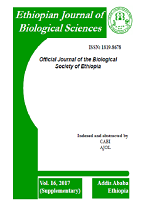ECOSYSTEM HISTORY OF THE BALE MOUNTAINS
Abstract
This paper presents results of the multiproxy palaeoenvironmental study of three zoogenic deposits, situated at the different altitudes in the Bale Mountains (South-central Ethiopia). Radiocarbon dating, pollen and diatom analyses were used to reconstruct the ecosystems‟ dynamics of the Bale Mountains during the Late Pleistocene and the Holocene. Pollen analysis revealed signals of the African Humid Period (AHP) and specified its precise time (15,000−4,600 cal yrs BP). The Weyib valley remained relatively arid from 15,000 to 8,600 cal yrs BP. A short humid period commenced at 8,500−8,000 cal yrs BP. Gradual climate aridization took place since 8,000 cal yrs BP. Diatom data show that the Sanetti plateau was relatively wet during the past 7000 years with some fluctuations in moisture. The plateau experienced more oxygenated systems after 2,500 cal yrs BP until now than before due to the creation of new lakes that indicate a humid climatic regime. The Weyib valley experienced a relatively humid period ca. 2,500 cal yrs BP. After the termination of the AHP, vegetation changes signaled the climate aridization that prevailed on more humid southern macroslope of the Bale Mountains and continued further during around 2,500 cal yrs BP, resulting in an extensive development of dry forests type of Olea, Hagenia and Podocarpus. Gradual climate aridity was interrupted by humid and warm period of 2,000−1,000 cal yrs BP. Noticeable human-induced environmental modification was registered on the Sanetti Plateau around 600 cal yrs BP, and around 1,000 cal yrs BP on the southern macroslope.
Key words/phrases: Bale
Downloads
References
Barker, P.A., Talbot, M.R., Street-Perrott, F.A., Marret, F., Scourse, J. and Odada, E.O.(2004). Late quaternary climatic variability in intertropical Africa. In: Past Climate Variability through Europe and Africa, pp. 117–138 (Battarbee, R.W., Gasse, F. and Stickley C.E., eds.). Kluwer Academic Publishers, Dordrecht.
Bartnitsky, A. and Mantel-Nechko, I. (1976). History of Ethiopia. Progress, Moscow. (In Russian).
Battarbee, R. (1986). Diatom analysis. In: Handbook of Holocene Palaeoecology and Palaeohydrology, pp. 527–570 (Berglund, B.E., ed.). John Wiley & Sons, Chichester.
Behre, K.-E. (1981). The interpretation of anthropogenic indicators in pollen diagrams. Pollen Spores 23: 225–245.
Berke, M.A., Johnson, T.C., Werne, J.P., Schouten, S. and Sinninghe Damsté, J.S. (2012). A mid-Holocene thermal maximum at the end of the African Humid Period. Earth Planet. Sci. Lett. 351: 95–104.
Beyens, L. (1989). Moss dwelling diatom assemblages from Edgeøya (Svalbard). Polar Biol. 9: 423–443.
More inside the PDF
